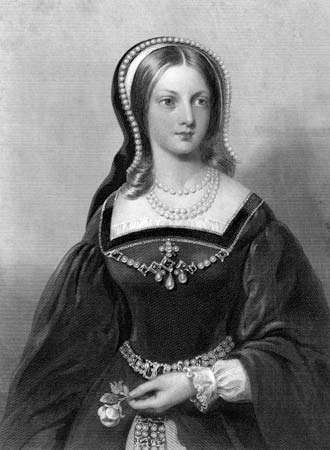The Fight for the Crown

(Lady Jane Grey was chosen by King Edward VI to succeed him on the throne, violating King Henry VIII's will.)
With Lady Jane Grey proclaimed queen on July 10, 1553, Mary knew she had not only been cheated, but betrayed. She was the rightful heir to the throne, but by John Dudley's slyness, she was having the crown taken away from her. For all her life, Mary had been trampled upon by her superiors—whether that be her father, her brother, Thomas Cromwell, or Thomas Cranmer. She put up a fight when she saw it fit, and surrendered when she saw it a necessity to survive.
But at this moment in her life, Mary knew there was only one option: she had to fight.
She started her fight for the crown by seeking safety for both herself and eventually for the establishment of a headquarters. Although this struggle was not a civil war, it had the makings of one. Armies were formed, troops marched, and the fight for the throne was about to unveil. However, Mary was at a major disadvantage—she was a queen with no army. Porter notes her situation best when she writes, "She commanded no army, no backers of any importance among the nobility, and Charles V had all but abandoned her." [26] Yet, like any underdog, she rose up to the challenge.
After avoiding the trap set by Dudley, Mary formed a headquarters for her war council at Kenninghall. From Kenninghall, Mary sent out letters to the knights and gentry of both Norfolk and Suffolk, seeking their assistance in her fight for the throne. She had already established an alliance with three leading East Anglian families, and this served as a small step to growing her army. For most of her backers, they supported Mary because she stood for Catholicism, and many rural regions outside of London still had spiritual ties to their old faith. Although similar rebellions to reinstall Catholicism in the past had failed (such as the Pilgrimage of Grace in 1536), Mary's supporters were willing to risk it all to reinstate someone they thought was the "unquestionable heir." [27]
As Mary revitalized her old rebellious self, the same rebel who resisted for three years her father's determination to disown her, she realized how many people were willing to die for her. The final major addition to her support was that from John de Vere, the earl of Oxford. De Vere was a prominent Protestant, making his support that much more galvanizing. After gaining de Vere's support, Mary had the army she was looking for. Subsequently, she proclaimed herself queen with regal authority on July 18, 1553. Porter notes that "having asserted her legitimacy, she makes clear her strength of arms." [28] Among many noble gentlemen who supported her, the Earl of Sussex, Lord Henry, was her Lieutenant General. In her proclamation as queen, Mary also calls out Dudley:
"Her most false traitor, John, duke of Northumberland and his complies who, upon most false and most shameful grounds, minding to make his own son king by marriage of a new found lady's title, or rather to be king himself, hath most traitorously by long continued treason sought, and seeketh, the destruction of her royal person, the nobility and common weal of this realm." [29]
On July 20, 1553, Mary rode out on her white horse and examined her army. Her horse reared in anxiety at the immensity of soldiers willing to die for Mary. Mary did not wish to look like she was losing control of her own horse, so she dismounted and inspected her army on foot. She was delighted at the sight of the sea of men standing at the ready to defend her right to be proclaimed queen. [30]
News of the size of Mary's army and the backing of much of the nobility scared both Dudley and the Privy Council to surrender before a single drop of blood was shed. After having inspected her army, she received word that she was proclaimed queen in London as of July 19, 1553. Lady Grey, nicknamed the "nine-day queen," was never formally crowned.
It was all over. Mary had won via a bloodless victory. As Porter summarizes, "Suddenly, the distant dream of her childhood was reality. The sorrow, the suffering, the fears of life spent in uncertainty were all part of her past." [31] Mary had made history. She was, is, and forever will be, the first ruling Queen of England.
Bạn đang đọc truyện trên: AzTruyen.Top